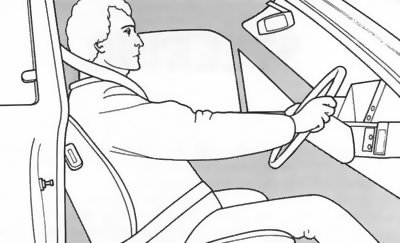The importance of adopting the correct driving position was outlined in Safety at the Wheel. To recap, you should sit neither hunched over the steering wheel nor too far from it. You should be comfortable, but not too relaxed. You should hold the wheel with your hands at the 'ten-to-two' or `quarter-to-three' position, and your arms should be bent to an angle of between 90 and 120 degrees. With your hands correctly positioned, you are best placed to make a sudden yet accurate and controlled movement of the steering, should a violent change of direction be demanded. It is impossible for a driver with both hands close together gripping the '12 o'clock' part of the wheel, or one fondling the wheel with one hand at '6 o'clock', to cope properly with an emergency manoeuvre.
Feeding the wheel
Steering movements should be made by feeding the wheel through your hands. This is how the technique works. When turning right, for example, pull the rim down a few inches with the right hand and let it slide through the fingers of the left. As your right hand reaches the bottom of the natural arc, keep up the turning movement by bringing your left hand, now gripping the rim, upwards. At the same time move your right hand up ready to repeat the operation. If you are not used to steering this way you may find that your movements feel somewhat uncoordinated, but it takes only a little practice to develop the technique into a neat, controlled movement which applies steering lock progressively while allowing you to retain a firm grip on the wheel at all times. They may not realise it, but a surprising number of people manage to let go of the wheel completely for long moments during normal driving.
The 'boy racer' straight arm technique — fine for the narrow confines of a racing car cockpit, but totally unsuitable for a road car.
This video course is the best way to learn everything about cars.
Three hours of instruction available right now, and many more hours in production.
- 4K HD with full subtitles
- Complete disassembly of a sports car
As you come out of a turn, straighten up by reversing the method. Do not allow either hand to stray beyond the `12 o'clock' position, because this greatly reduces the degree of fine control you have over the steering. Even when you have applied considerable lock through a tight turn, your hands should still remain opposite each other, ready to apply corrective lock if you skid or extra lock should it be needed.
As you come out of a bend it can be tempting to allow the steering's self-centring action to pull the wheel back to the straight-ahead position by letting the rim slip through your fingers. Advanced drivers do not do this because it has a serious disadvantage when sudden steering movement is necessary. Valuable fractions of a second are wasted regaining a grip on the wheel and then working out just where the front wheels are pointing in relation to the steering. Only during low-speed manoeuvring, perhaps when turning round in a car park, can this method be regarded as acceptable. Although it is never strictly necessary, it is acceptable when parking or reversing to take one hand past '12 o'clock' on the rim.
At all other times the 'crossed hands' style at the wheel should be avoided because it prevents you from being in perfect control of the steering. Racing drivers can be seen crossing their hands (at least in the days when the driver was visible in his car), but for them speed is of the essence, danger is a secondary consideration and there is room to make mistakes. None of these aspects apply on public roads.
Steering accurately
Many motorists do not take the trouble to judge accurately the width of their cars, showing that they imagine the vehicle to be three feet wider than it really is by giving an excessively wide berth to any obstacle. Acquiring a precise idea of your car's width and length enables you to negotiate a path through congested traffic more easily, or to squeeze into a tight parking spot which once would have looked too small. You can learn to steer accurately and judge the dimensions of your car by practicing with markers in an empty car park on a Sunday morning. Once this art is perfected, do not exploit it unwisely by passing parked cars or overtaking with only inches to spare, or taking left-hand bends within a hair's breadth of the kerb.
Gentle but firm touch
As well as positioning the hands correctly, you should also grip the wheel in the right way. Timid or inexperienced drivers often grip the wheel so tightly that the whites of their knuckles show. Apart from being tiring, an excessively strong grip also tends to make steering movements coarser, which can cause the car to drift from side to side when cruising at 70mph on a motorway. With properly adjusted steering any car should run straight, but to do so it responds best to a light, but firm, hold. Most cars are influenced by strong cross-winds or by the buffeting which occurs when passing a large coach or truck on the motorway, and in these circumstances a gentle touch is best for applying tiny steering corrections. Steering a car is like horse riding: keep a firm but gentle hold on the reins. If perspiration makes a plastic steering wheel rim slippery, use a lace-on leather cover, or driving gloves thin enough to permit sensitive touch.
Never wear thick gloves when driving in winter before the heater has had a chance to warm the car through. They are clumsy, can affect your grip and tend to make your steering movements coarse, which in wet or icy conditions can lead to a skid. Since you are not such an alert driver when you are shivering, it is best to let the car warm up for five or ten minutes before setting out on a winter journey.
Understeer and oversteer
The position of a car's front wheels in an understeer situation (left) and an oversteer situation (right).
Sensitivity in steering is of crucial importance, especially if your car has power-assisted steering. Most systems are far more sophisticated than they used to be, some cars now having a degree of assistance which varies according to speed, but the driver may still be denied some of the all-important steering 'feel'. Messages through the steering about how the front wheels are reacting to the road surface give the experienced driver a great deal of useful information. Power-assisted steering, which seems to mask this feedback from the front wheels, must be treated with respect because it is all too easy for a sudden steering movement on a wet road to cause the front wheels to break grip and start a front-wheel skid. Artificial lightness should not be taken to mean that your car's road-holding is any better.
Basic handling
We cannot leave the subject of steering without discussing the much-quoted - and often misunderstood - terms of oversteer' andundersteer'. These refer to the basic handling characteristics of a car, not to any action taken by the driver. Most cars, particularly those with front-wheel drive, tend to need more steering lock than might be expected to hold course through a bend, especially at higher speeds: this is understeer. Other cars, particularly rear-engined and many rear-wheel drive models, can need less steering lock than would be expected, requiring the driver to ease off the steering slightly to keep the car on course: this is oversteer. The 'under' and 'over' refer to how the car responds to being deflected from the straight and narrow by the steering.
Summary
- Always steer by feeding the wheel through your hands, so that you have at least one hand gripping the rim at all times; crossing the hands is not the best way to control the steering.
- Learn to steer accurately with a clear idea of your car's width; avoid coarse movements which in poor conditions may cause the front wheels to skid.
- Hold the wheel with a gentle but firm touch, for maximum sensitivity.




